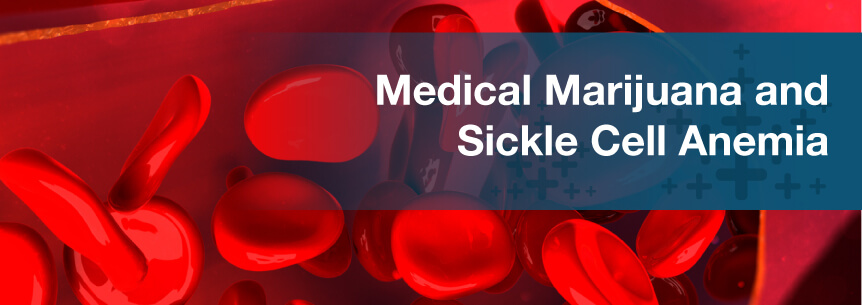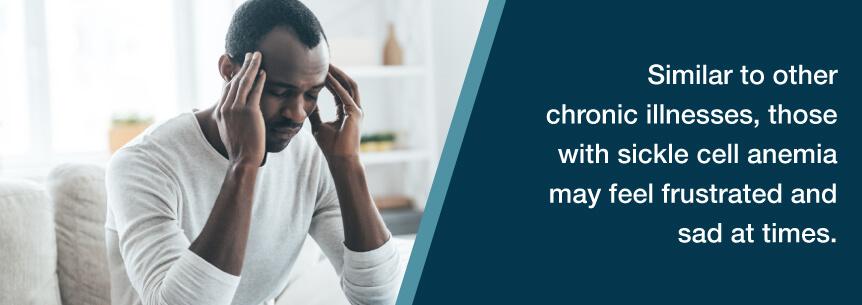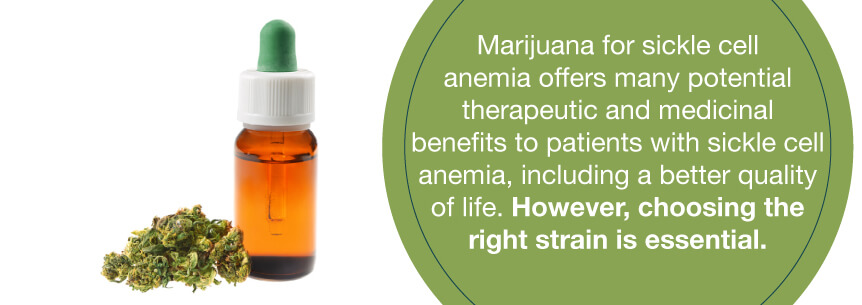
People have been using cannabis medicinally for quite some time now. Patients have benefited from the herb to treat a wide range of symptoms, from conditions like arthritis and epilepsy to chronic pain. Now, patients can benefit from medical marijuana for sickle cell anemia as well.
Sickle cell anemia, one type of sickle cell disease, is a form of anemia that you inherit from your parents. It’s a condition where you’re not getting sufficient oxygen throughout your body because you don’t have enough healthy red blood cells to carry it.
Normally, you have round and flexible red blood cells moving through your blood vessels smoothly. When you have sickle cell anemia, also called sickle cell disease (SCD), your red blood cells become sticky, rigid and shaped like crescent moons or sickles. These abnormally-shaped cells can slow or block oxygen and blood flow to different areas of your body because they get stuck in your small blood vessels. They also die sooner than normal blood cells.
Sickle cell anemia has no cure, but available treatments help to alleviate your pain and help prevent further complications.
Several types of sickle cell disease exist, with sickle cell anemia, or hemoglobin SS disease, being the most common.
Hemoglobin is a red protein in your red blood cells that transports oxygen to the tissues of your body. It normally has two beta chains and two alpha chains, but mutations in any of these genes can lead to sickle cell anemia. There are four primary types of the disease, depending on which genes are mutated:
Other rare types of SCD that don’t typically have serious symptoms include:
Sickle cell trait is another type. You have sickle cell trait when you inherit only the hemoglobin S mutated gene from one parent. You may not experience any symptoms, but you can pass the trait along to your children.
In medical history chronicles, the year 1910 is observed as the discovery date of SCD in the United States, but people in Africa had been dealing with SCD for a minimum of five thousand years. As more cases started to appear, it only deepened the mystery of the disorder. What was clear, however, is it was a more common occurrence in people of African origin.
Early diagnosis and intervention decrease mortality and morbidity, and this led to newborn screening and education programs all over the world.
Symptoms and signs of sickle cell anemia can change over time and vary between people. Some include:
Your red blood cells can typically live around 120 days before they die, and your body replaces them. Sickle cells easily break apart and often die within 10 to 20 days. This means your body can’t replace them as quickly as necessary, and your body faces a shortage of red blood cells — this is anemia. When you don’t have enough red blood cells, there’s not enough oxygen flowing throughout your body, which results in fatigue.

Periodic pain episodes, referred to as crises, are a common symptom of SCD. When you have sickle-shaped red blood cells blocking the flow of blood through the tiny blood vessels to your joints, chest and abdomen, pain develops. You may also experience pain in your bones.
Your pain can last anywhere from several hours to several weeks and vary in intensity. While some patients experience pain episodes only a few times, others experience them a dozen or more times a year. You may even require hospitalization if your pain episode is severe enough.
Some adults and adolescents with SCD have chronic pain as well due to ulcers, joint and bone damage or other causes.
You require red blood cells to obtain the nutrients and oxygen your body needs to grow. When babies and children don’t have enough of these healthy red blood cells, it can slow their growth. In teenagers, it can delay puberty.
Sickle cells may cause damage to your spleen and leave you susceptible to frequent infections. Physicians usually give babies and kids antibiotics and vaccinations when they have sickle cell anemia to prevent pneumonia or other potentially life-threatening infections.
When the sickle-shaped red blood cells obstruct the flow of blood to your feet and hands, it can cause painful swelling.
Sickle cells can plug up the tiny vessels that supply your eyes with blood, causing damage to the retina. Your retina is the part of your eye allowing you to process visual images, so a damaged retina can lead to vision problems.
You could experience some complications with sickle cell anemia such as:
Pain episodes or crises can suddenly occur when you have a blockage in blood flow, decreasing the delivery of oxygen. Patients report the pain may feel intense, sharp, throbbing or stabbing. Pain may occur anywhere throughout your body and even in several areas at a time. However, the pain usually strikes areas like your:
Various factors can bring on a crisis such as:
Most patients don’t know the causes or triggers of their crises.
Many adult or adolescent SCD patients struggle with chronic pain. The pain they experience is not the same as the pain from a crisis. It can become severe enough to make life difficult all the time.
SCD patients with damaged spleens may become sick with severe and sometimes life-threatening bacterial infections like:
Bacteria may lead to:
Most patients have a mild form of anemia with SCD, but some may experience severe anemia, which can be life-threatening.
Other complications or effects of sickle cell anemia may include:
Similar to other chronic illnesses, those with sickle cell anemia may feel frustrated and sad at times. SCD imposes limitations on patients’ daily activities, causing them to feel isolated from other people. Additionally, the stress of coping with the fatigue and pain along with frequent hospitalizations and medical visits can lead to depression.

Facts about sickle cell anemia according to the Centers for Disease Control and Prevention (CDC) include the following:
The American Society of Hematology says:
Certain ethnic groups are more likely to develop the disorder, including:
Current treatments for sickle cell disease include:
During a bone marrow transplant, the surgeon replaces sickle cell anemia-affected bone marrow with healthy bone marrow donated by a donor. Also called a stem cell transplant, this procedure is the only treatment potentially offering a cure to SCD patients. Surgeons perform this procedure on younger people who are 16 years old or younger since those older than 16 years old have more risks, including death.
Because of the high risks of bone marrow transplants, however, doctors usually focus treatment on relieving symptoms, avoiding crises and preventing complications.
Some medicines doctors prescribe for sickle cell anemia include:
Less serious side effects of hydroxyurea may include:
With painkillers, you may experience mild side effects such as nausea, vomiting, and diarrhea. Addiction can occur if you take narcotic painkillers for an extended time.
Antibiotics may produce side effects such as:
With red blood cell transfusions, the surgeon removes the red blood cells of a donated blood supply and gives them to you intravenously.
Blood transfusions increase your circulating healthy red blood cells to help treat anemia. Kids with SCD who have a high stroke risk benefit from blood transfusions because it decreases this risk. A blood transfusion also prevents or treats other SCD complications.
You do have some risk with blood transfusions, including an extra buildup of iron in your body as well as infection. Too much iron can damage your liver, heart and other organs, so those undergoing regular blood transfusions may require treatment to lower their iron levels.
During a study, researchers found cannabis had a negative effect on Vaso-Occlusive Crises (VOCs). Researchers think it could be due to cannabis’s effect on the brain or how severe the disease is in marijuana users. To clarify these findings, researchers need more controlled studies.

Presently, researchers are conducting a trial to see if inhaling vaporized cannabis may ease chronic pain in SCD patients. The researchers are also looking at potential synergistic effects of opioids and inhaled cannabis since the patients in the study are also taking chronic opioid analgesics.
Researchers hypothesize:
Sickle cell disease is a qualifying condition for medical marijuana in a number of states, including Connecticut, Georgia, Ohio, Pennsylvania and West Virginia.
Along with the uplifting, mood-enhancing and euphoric effects medical marijuana provides, it also provides anti-inflammatory and pain relief properties helpful to sickle cell anemia patients.
Medical cannabis for sickle cell anemia can affect a patient’s pain significantly. The cannabinoids marijuana contains work in your body’s endocannabinoid system with your natural receptors. This interaction reduces inflammation, eases pain and helps with your body’s other processes.
Relieving inflammation, pain and depression linked with SCD can improve patients’ quality of life and help them live a normal life. It may also increase the number of activities patients will be able to do.
Eighty-six sickle cell anemia patients took a survey in a 2005 study. Their responses revealed that:
Marijuana for sickle cell anemia offers many potential therapeutic and medicinal benefits to patients with sickle cell anemia, including a better quality of life. However, choosing the right strain is essential.

As you’ve read, sickle cell anemia can produce a lot of pain and inflammation. Therefore, strains focusing on these side effects may prove to be beneficial to you.
Indica-dominant strains help to relax you and aid with sleep. These strains are suitable for nighttime or when you’re looking to rest a bit. Indica-dominant strains help you fall asleep easier and alleviate your pain.
Sativa-dominant marijuana strains are more energizing and uplifting. They’re good daytime medicines and will provide you with energy while also relieving your pain and inflammation.
Many medical marijuana strains help with chronic pain. Some effective pain-relieving strains you may want to try include:
Inflammation-fighting strains to try include:
As new strains become available, work with your dispensary budtender or medical marijuana doctor to find the optimal strains for you.
The way you consume marijuana is another important factor to consider when using cannabis for sickle cell anemia treatment. When experiencing the acute, severe pain SCD produces, quick pain relief is all you can think of. By vaporizing or smoking medical weed, you’ll experience almost immediate effects. These methods are useful for individuals suffering from crises.
Vaporizing or smoking medical pot may produce quick effects, but the effects aren’t as long-lasting as other methods. For instance, edibles provide you with longer-lasting relief, but it can take a while for you to feel their effects.
Another option is topicals. Topicals can come in creams, lotions, balms, salves and other applications you apply to specific areas of your body for targeted relief.
For more information on cannabis and sickle cell anemia as well as to find a doctor in your area, visit MarijuanaDoctors.com. In addition to medical marijuana news and resources, you’ll get access to a list of cannabis dispensaries and a directory of qualified doctors who are waiting to help you find the relief you need from sickle cell anemia.
Find A Doctor Find A Dispensary